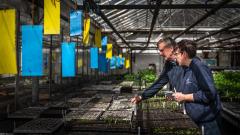It could be described as a revolution in livestock management with Paul Flynn, Director of Agriculture at East Durham College and his experienced team of staff, very much in its vanguard.
“It’s more about grassland management,” explained Paul “but rotational grazing can deliver a range of big benefits for farmers. It’s an easy win at very little cost and is gradually building an eager audience within agriculture as well as participation in schemes and trials right across the UK.”
Paul, who has farmed extensively including a spell in New Zealand, is in charge of the 476-acre college farm near the centre of the charming city of Durham that combines beef, sheep, pig and arable farming.
Paul went on “Ryegrass can produce over 10t of dry matter per hectare but only if given chance to rest between grazing. Not only does this make for more grass, about twice as much, but cattle and sheep make much better use of it!
“The quick turn-around prevents the usual waste, caused by stomping and defecating on the grass. Instead, the grass is soon eaten with little going to waste. This creates a young uniform layer, ready to grow for next time.
“After grazing, the plant goes through a period of recovery, using scarce resources to rebuild leaf. Any grazing at this time slows the recovery. We try to graze for no more than two or three days, to avoid this. It’s like watching a boxer just getting up off the ground; one more hit at this stage and it’s all over!
“Grass is the perfect food for livestock. High in energy, protein and easy to digest, except when it’s not! As the grass grows older and starts to produce a stem, flower and seed, the feed value declines rapidly. Timing is key. Grazing promptly, before the grass has time to mature, maximises nutrient availability.
“Does this wear the field out? Does it have to be resown after a couple of years of this intensive grazing? No! Putting the grass first, grazing when it best suits the grass, can extend the life of the field, avoiding the costly process of resowing.
“I’m not sure what the cows and sheep make of it but they quickly adapted to the electric fencing. Previously, cattle have broken through it, creating a spaghetti of orange coloured plastic wire.
“Following advice and the experience of our farm staff, we rigged up a short section of fencing at the back of the large cattle shed before turn-out. On release, the cattle completed a 400m loop of the field before recognising the spaghetti! To our surprise, they’ve really respected the fence. Modern systems are much more powerful and solar charging has kept them at full potential. They’re also much lighter and quicker to use than earlier versions.
“As a lowland farm with well-drained sandy loam, the soil can quickly dry out. We’ve already generated excess grass, baling 37 bales of silage from one field alone. The trick will be to use this to buffer the grass availability when we need to. We shouldn’t be afraid to use silage in the summer, this is the norm in many other countries.
“We’ve yet to weigh the cattle but the signs are obvious; great body condition and strong flowing muscle. We expect weight gain to top 1Kg per day. This could mean cattle achieving target weights sooner, reducing our costs, making space for more cattle and cashing in an early return. Longer term, this should allow us to increase the number of sheep and cattle we can hold on the farm and remove our reliance on purchased feed, selling pasture fed beef and lamb. By adding clover to our resown grass fields we should be able to provide all the protein we need. Clover can also add nitrogen to the soil, reducing the cost of fertiliser. That’s our next campaign.
“Consultant James Daniel helped us to introduce the system. His test cases, published by AHDB, involved work on three farms. Feedback was positive in each case. The only problem? Finding enough sheep and cattle to keep up with the supply of grass!
“Farm Manager Keith Cook and Assistant Iain Whitfield had already been creating smaller more manageable fields with additional fencing and hedges for shelter. They have really embraced this and are looking for further improvements all the time,” added Paul.





